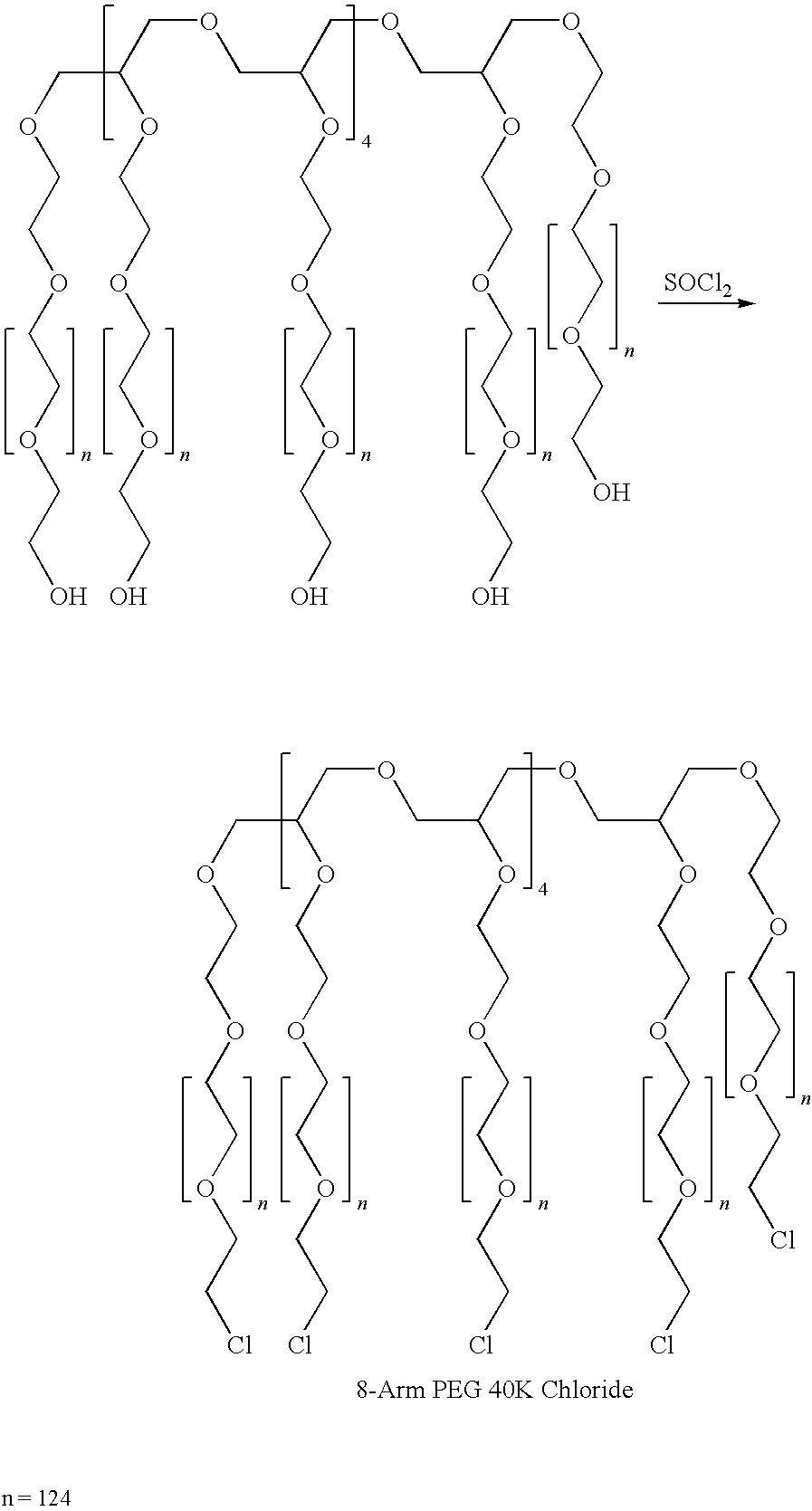Method for preparing a hydrogel adhesive having extended gelation time and decreased degradation time
a hydrogel and degradation time technology, applied in the field of medical adhesives, can solve the problems of limited internal application use of fibrin-based adhesives, slow curing of fibrin-based adhesives, and inconvenient use of conventional tissue adhesives, so as to reduce the number of groups available for crosslinking, prolong the gelation time, and reduce the degradation time of hydrogels
- Summary
- Abstract
- Description
- Claims
- Application Information
AI Technical Summary
Benefits of technology
Problems solved by technology
Method used
Image
Examples
example 1
Extending Gelation Time of a Dextran Aldehyde-PEG Amine Hydrogel Using Glucosamine Free Base
[0126]The purpose of this Example was to extend the gelation time of a hydrogel formed by reacting a mixture of dextran aldehydes with a mixture of a 4-arm PEG amine and an 8-arm PEG amine using different amounts of glucosamine free base. Glucosamine was combined with an aqueous solution of dextran aldehyde in order to reduce the number of active aldehydes, resulting in a slower and more-controlled gelation time upon combination with an aqueous solution of the mixed multi-arm PEG amines.
[0127]The following aqueous solutions were prepared:
[0128]1A: a dextran aldehyde solution prepared by combining in equal volumes a 25 wt % dextran aldehyde solution (50% oxidative conversion, average molecular weight 8,500-11,500, prepared using the method described in General Methods) and a 25 wt % dextran aldehyde solution (20% oxidative conversion, average molecular weight 8,500-11,500, prepared using the m...
example 2
Extending Gelation Time and Time-to-Tack-Free of a Dextran Aldehyde-PEG Amine Hydrogel Using Glucosamine Free Base at High pH
[0133]The purpose of this Example was to extend the gelation time and time to-tack-free of a hydrogel formed by reacting dextran aldehyde with an 8-arm PEG amine using glucosamine free base at high pH.
[0134]Dextran aldehyde, average molecular weight 8,500-11,500; 40% oxidative conversion, prepared using the method described in General Methods, (0.20 g, 1.10 mmol of aldehyde) and 0.24 g (1.10 mmol) of glucosamine hydrochloride were dissolved in 0.72 g of deionized water. After dissolution was complete, 0.088 g of a 50% sodium hydroxide solution (1.10 mmol) was added to convert the glucosamine hydrochloride to the free base form. An 8-arm PEG amine (Mn=10,000, Nektar) solution (30 wt %) was prepared in deionized water. The dextran aldehyde / glucosamine solution and the 8-arm PEG amine solution were mixed in ratios of 1:1, 2:1, and 1:2 and the gelation times and t...
example 3
Extending Gelation Time of a Dextran Aldehyde-PEG Amine Hydrogel Using Glucosamine Hydrochloride
[0135]The purpose of this Example was to extend the gelation time of a hydrogel formed by reacting a mixture of dextran aldehydes with a mixture of a 4-arm PEG amine and an 8-arm PEG amine using different amounts of glucosamine hydrochloride. Glucosamine hydrochloride was combined with an aqueous solution of dextran aldehyde in order to reduce the number of active aldehydes. The lower pH resulting from the hydrochloride salt also reduced the number of active amines in the mixture resulting from the combination of the dextran aldehyde solution and the PEG amine solution. The addition of the glucosamine hydrochloride resulted in a slower and more-controlled gelation time for the hydrogel.
[0136]The following aqueous solutions were prepared:
[0137]2A: a dextran aldehyde solution prepared by combining in equal volumes a 25 wt % dextran aldehyde solution (50% oxidative conversion, average molecu...
PUM
| Property | Measurement | Unit |
|---|---|---|
| number-average molecular weight | aaaaa | aaaaa |
| equivalent weight | aaaaa | aaaaa |
| number-average molecular weight | aaaaa | aaaaa |
Abstract
Description
Claims
Application Information
 Login to View More
Login to View More - R&D
- Intellectual Property
- Life Sciences
- Materials
- Tech Scout
- Unparalleled Data Quality
- Higher Quality Content
- 60% Fewer Hallucinations
Browse by: Latest US Patents, China's latest patents, Technical Efficacy Thesaurus, Application Domain, Technology Topic, Popular Technical Reports.
© 2025 PatSnap. All rights reserved.Legal|Privacy policy|Modern Slavery Act Transparency Statement|Sitemap|About US| Contact US: help@patsnap.com



